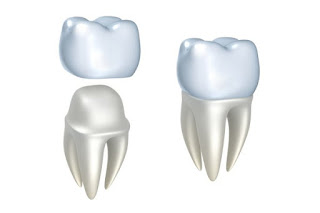 Dental crowns are used to repair a number of different issues with teeth, providing a strong and stable solution that can greatly extend the life of your teeth. When it comes to dental crowns, you have a great deal more choices than you did a few years ago. While we have been working diligently to improve dental crowns, this has created a situation where you have to select between a variety of options. Some people swear by the full porcelain crowns, however, we have learned that when it comes to dental crowns there is no one size fits all solution, meaning you may actually not be the best fit for them. What is challenging is that so few people really understand the differences between the types of crown materials used, or the pros and cons of each of them. We can explain to you what the best kind of material for your mouth is and why during your appointment.
Dental crowns are used to repair a number of different issues with teeth, providing a strong and stable solution that can greatly extend the life of your teeth. When it comes to dental crowns, you have a great deal more choices than you did a few years ago. While we have been working diligently to improve dental crowns, this has created a situation where you have to select between a variety of options. Some people swear by the full porcelain crowns, however, we have learned that when it comes to dental crowns there is no one size fits all solution, meaning you may actually not be the best fit for them. What is challenging is that so few people really understand the differences between the types of crown materials used, or the pros and cons of each of them. We can explain to you what the best kind of material for your mouth is and why during your appointment.
Porcelain dental crowns were, and still are, the best material to use when it comes to an aesthetic point of view. Porcelain looks and feels almost exactly like enamel, which means that once a dental crown is placed, the tooth is almost identical to the natural teeth. There are some other advantages to using porcelain to make dental crowns. For example, porcelain is a poor conductor of heat, which means that your teeth will experience far less sensitivity to cold and hot substances in the immediate aftermath of placing the crowns. Porcelain is extremely hard, making it very durable. This, however, also creates a disadvantage in some situations. The hardness of porcelain can cause it to wear down the opposing teeth. The other disadvantage to porcelain dental crowns is that porcelain tends to be more fragile and if mistreated can crack.
Gold has been used to created dental crowns for a very long time. For a while, gold dental crowns were the standard to which everyone aspired. Gold, like porcelain, has both advantages and disadvantages when used to create dental crowns. Some of the advantages are that gold can be attached, or bonded, to the teeth using a glass ionomer. This is advantageous because fewer people have a sensitive reaction to the glass ionomer bonding than do the more comprehensive bonding techniques used when placing porcelain crowns. In addition to this, gold is very durable, which means your crowns will last a long time. To make gold more durable, the crowns are made of an alloy which includes other metal like titanium, palladium, and silver to make the gold harder since in its purest state gold is extremely soft. Gold dental crowns also put less pressure on the opposing teeth, meaning they will cause less wear. As far as disadvantages go, the most obvious is the fact that gold is not the color of teeth and cannot be used to repair front or prominently visible teeth. In addition to this gold is a good conductor of heat, which can increase a patient's sensitivity to hot and cold substances immediately after the procedure. For these reasons, most of our patients select a tooth-colored dental crown but we can discuss both options with you during an appointment.